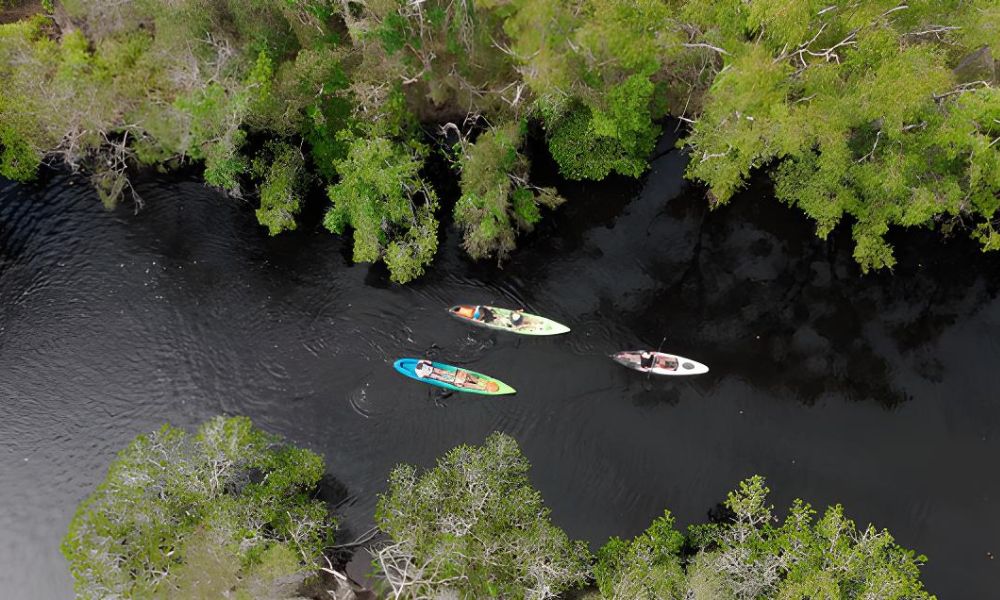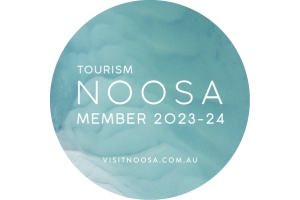Understanding the Noosa Biosphere
What Is the Noosa Biosphere Reserve?
The Noosa region is internationally recognised as a UNESCO Man and the Biosphere (MAB) Reserve, officially designated in 2007. This places Noosa in a global network of more than 700 biosphere reserves across 134 countries.
But what actually is a biosphere reserve?
Why was Noosa chosen?
And what does that mean for the landscapes visitors explore today?
This explainer breaks it down….


According to the UNESCO Man and the Biosphere Program, biosphere reserves are:
“Sites that support a balanced relationship between humans and nature through conservation, sustainable development, and learning.”
Every biosphere reserve, anywhere in the world, is built around three core functions:
1. Conservation
Protecting ecosystems, species, waterways and cultural heritage.
2. Sustainable Use & Development
Supporting tourism, recreation, farming and community life in ways that protect long-term environmental health.
3. Education, Research & Learning
Serving as ‘living laboratories’ where communities, operators, scientists and schools can study how humans and nature coexist.
A biosphere reserve is not a wilderness zone and not a national park.
It includes towns, farms, trails, forests, wetlands and waterways — all managed as one interconnected system.
This is the foundation of why Noosa has such a high level of nature-based attractions and activities within minutes of urban areas.
The entire region is designed — structurally, culturally and historically — around coexistence between people and the environment.
The Structure of a Biosphere Reserve
UNESCO biosphere reserves use a three-zone model:
1. Core Conservation Areas
Highly protected ecosystems such as national parks, wetlands and significant waterways.
In Noosa:
- Noosa National Park
- Tewantin National Park
- Great Sandy National Park (including the full connected Everglades-type wetland system across the catchment)
- Lake Weyba wetlands
- Lakes, swamps and tannin wetlands throughout the lower, mid and upper catchment
2. Buffer Zones
Areas managed for low-impact recreation, research and conservation.
In Noosa:
- Wooroi MTB network
- Noosa Trail Network
- Lake Weyba estuarine margins
- Foreshore reserves around the lakes and river
- Conservation estates
3. Transition Zones
Where communities live, work and recreate.
In Noosa:
- Noosa Heads, Noosaville, Sunshine Beach
- Cooroy, Cooran, Pomona
- Mixed-use rural landscapes
- Riverfront communities
Because these zones are designed to work together, Noosa becomes one of the few places where visitors can step from an urban café straight into significant natural habitat — and where world-class nature-based experiences coexist with everyday life.


Why Was Noosa Chosen as a Biosphere Reserve?
1. Whole-of-Catchment Ecological Connectivity
UNESCO recognised that the entire Noosa River Catchment — from mountains to sea — functions as a single ecological system, including:
- Lake Macdonald
- Doonella
- Lake Weyba
- Cooroibah & Cootharaba
- Lower river estuary, mangroves and seagrass
- Mid-catchment wetlands
- Northern river wetlands (often marketed as the “River of Mirrors”)
All of these landscapes share the same low-nutrient, tannin-influenced, interconnected wetland characteristics.
2. Exceptional Biodiversity
The region spans:
- dunes
- subtropical forest
- dry sclerophyll
- wallum heath
- mangrove and seagrass systems
- freshwater & brackish lakes
- extensive catchment-wide wetland systems
- volcanic peaks and rocky outcrops
3. Strong Community-Led Conservation Culture
Decades of community activism and planning decisions have protected the region’s ecological assets.
4. A Demonstrated Ability for Humans and Nature to Coexist
This is one of the defining reasons Noosa received UNESCO status.
Unlike strict national parks or wilderness zones, biosphere reserves actively showcase how human communities can live within a natural environment without degrading it.
This is precisely why Noosa has:
- MTB trails woven through conservation buffers
- kayak-friendly low-nutrient wetland systems near town
- birdlife-rich lakes beside residential areas
- mangroves and seagrass meadows directly beside urban precincts
- easily accessed walking trails, headlands and river systems
- forested ridges rising directly behind towns
- the ability to enjoy nature minutes from cafés, schools, and neighborhoods
The coexistence model is not an accident — it is the core purpose of biosphere designation.


What Makes the Noosa Biosphere Reserve Unique?
✔ A complete mountains-to-sea ecological gradient
Hinterland peaks → wetlands → lakes → mangroves → river mouth.
✔ A full catchment-scale Everglades-type system
Including southern wetlands (Lake Weyba), mid-catchment channels and lakes, and northern river wetlands — all part of one hydrological and ecological whole.
✔ Nature-based recreation integrated into planning
Trails, waterways, beaches and networks exist because Noosa’s planning system was built around coexistence.
✔ Towns embedded within natural landscapes
Visitors can access significant nature moments away from urban Noosa — a hallmark of biosphere design.
✔ A long-standing culture of protection
From local councils to community groups and environmental education centres.


How Visitors Experience the Biosphere
Visitors experience the biosphere through everyday interaction with nature, not only remote wilderness areas.
This includes:
- riding through forest reserves five minutes from town
- paddling through wetlands in both southern and northern catchment areas
- exploring coastal headlands minutes from Hastings Street
- walking or riding through mangroves and paperbark forests
- observing wildlife in lakes beside residential areas
- accessing beaches and trails that exist because development was intentionally limited
- enjoying water-based and forest-based recreation embedded safely within the natural landscape
People and nature aren’t separated.
They coexist — everywhere, including right beside urban Noosa.


Where We Operate Within the Noosa Biosphere Reserve
We operate across several distinct landscapes within the Noosa Biosphere Reserve — each one showcasing how people and nature coexist in this globally recognised environment.
Our tours don’t cover the entire biosphere, and we don’t claim to.
Instead, we focus on areas where nature-based experiences, cultural landscapes and accessible adventure come together.
Below is an overview of the environments we work in.
Everglades Experience — Lake Weyba & Connected Wetlands
Our water-based tours operate within the southern reaches of the Noosa River Catchment, centred around Lake Weyba and the surrounding low-nutrient wetland channels.
These areas are part of the same interconnected catchment-wide Everglades-type wetland system, recognised for:
- tannin-stained reflective waterways
- expansive seagrass meadows
- mangrove forests
- wallum heath wetlands
- high birdlife diversity
- extremely low nutrient loads
Unlike the remote northern river wetlands, the southern system offers a more accessible Everglades-style experience, with:
- shorter paddles
- calmer water
- easy logistics
- shorter travel times from Noosa
- multiple environment types close together
We do not claim this area is the same as the northern river wetlands — simply that it is part of the same connected wetland system, with its own identity, ecological role and character.
Urban–Nature Interface Experiences — Noosaville, Tewantin & Coastal Corridors
A defining feature of a UNESCO Biosphere Reserve is that people and nature coexist — and few places demonstrate this better than Noosa’s urban–nature interfaces.
Our guided cycling experiences explore:
- riverside paths beside mangroves and wetlands
- estuarine edges with abundant birdlife
- shared paths that weave between natural areas and community spaces
- forest corridors and quiet backstreets linking green zones
- historic river precincts shaped by both people and environment
These tours highlight a uniquely Noosa phenomenon:
Significant natural values remain immediately adjacent to residential and urban areas — a result of decades of conservation-focused planning.
Visitors see how the biosphere model works in practice with towns surrounded by functioning ecosystems, with nature accessible within minutes.
Hinterland & Biosphere Trail Experiences — Mountains, Forests & Rural Valleys
Our mountain biking and e-bike tours operate deeper into the hinterland and forested buffer zones of the biosphere.
These areas include:
- Wooroi Forest (Tewantin National Park)
- Noosa Trail Network
- Kin Kin, Cooran and Cootharaba ridgelines
- Forested volcanic hills and conservation estates
- Rural valleys where farmland and habitat coexist
- Wallum and paperbark wetlands connected to the wider catchment
This part of the biosphere shows a different expression of the landscape:
- rolling hills
- dry forests
- creek lines feeding the main river system
- panoramic viewpoints across the catchment
- quiet rural communities within protected landscapes
These experiences demonstrate the “living laboratory” side of the biosphere — working landscapes, conservation areas and recreation zones operating together.


How These Areas Fit Together
While each region has its own character, they are all part of the same UNESCO-recognised biosphere and the same interconnected catchment system, where:
- mountains feed creeks
- creeks feed wetlands
- wetlands feed lakes
- lakes feed the river
- the river feeds the estuary
- and all of these landscapes coexist alongside communities
We operate responsibly within these areas, focusing on environments that:
- are accessible
- support low-impact nature-based recreation
- provide meaningful insight into the biosphere
- showcase the diversity of the Noosa landscape
- allow visitors to experience nature at their own pace
Award Winning Tours
As the honored recipients of Airbnb’s ‘Most Magical Experience’ and TripAdvisor’s ‘Travelers’ Choice Award,’ alongside a multitude of glowing 5-star reviews, you can trust that an extraordinary adventure awaits you.
PERFECT FOR KIDS
AND FAMILIES
All our kayak adventures are conducted in shallow waters on super-stable double kayaks, with infant seats available.
We offer a diverse array of family-friendly bike adventures that can be tailored to families with young children. Please contact us for details as not all our bike tours can be made child friendly.
Easy Access, Minutes from Noosa
Embark on our serene kayak adventures, set in the tranquil shallow waters just minutes from the heart of Noosa, and our bike tours departing from Noosaville. These accessible and unique adventures offer an extraordinary opportunity to uncover some of Noosa’s best-kept secrets.
By Earth and Ocean offers complimentary transfers from your Noosa accommodation on selected tours and days (subject to availability)





